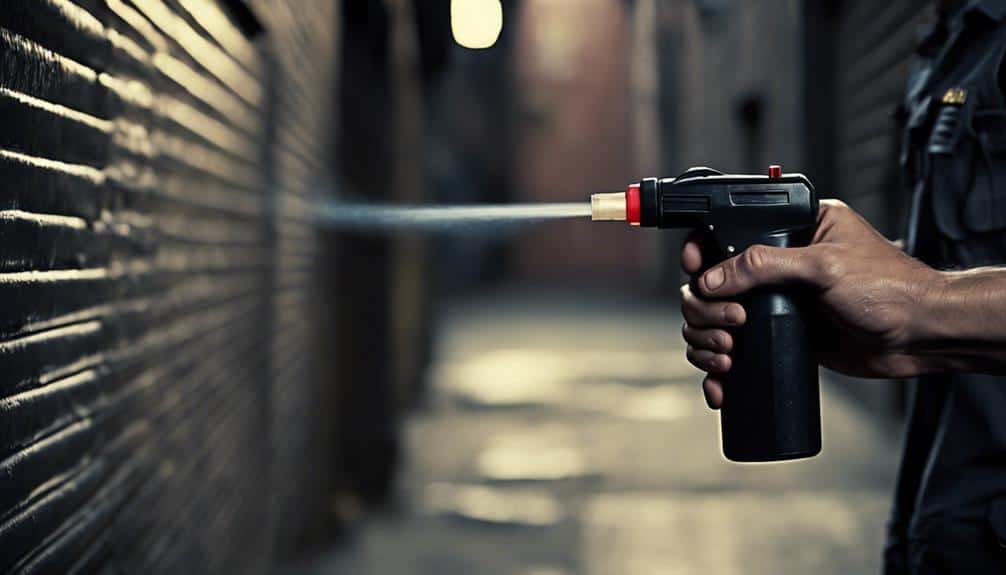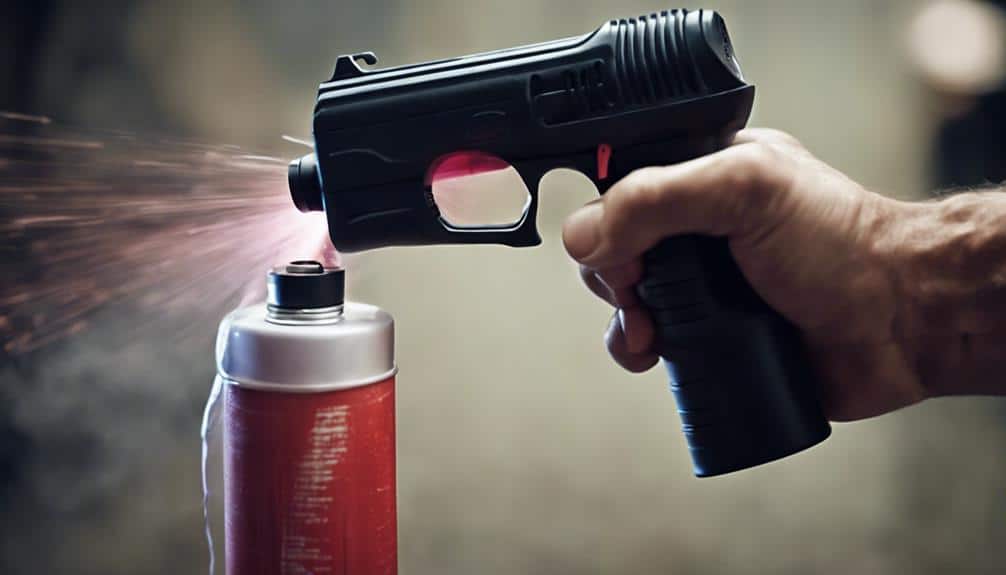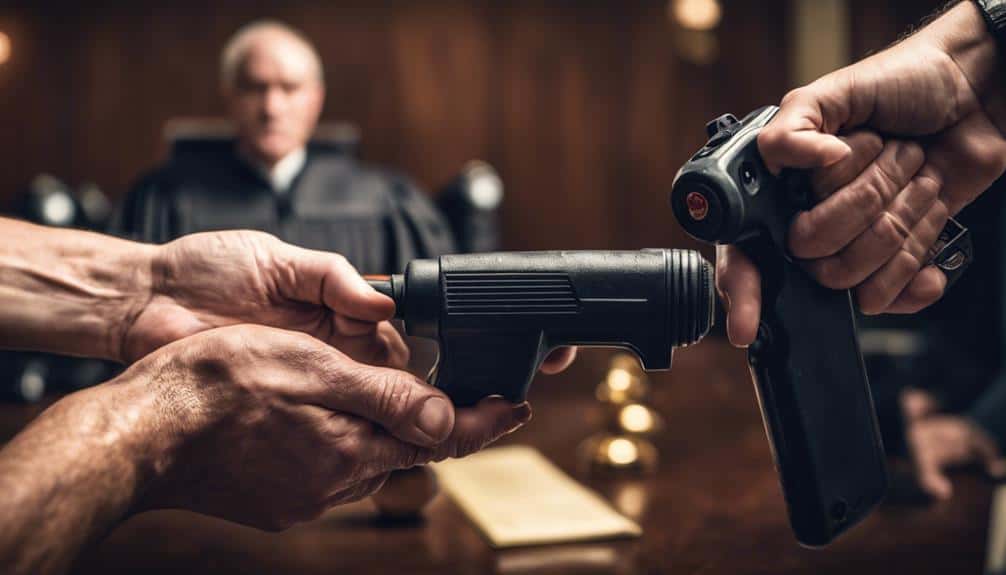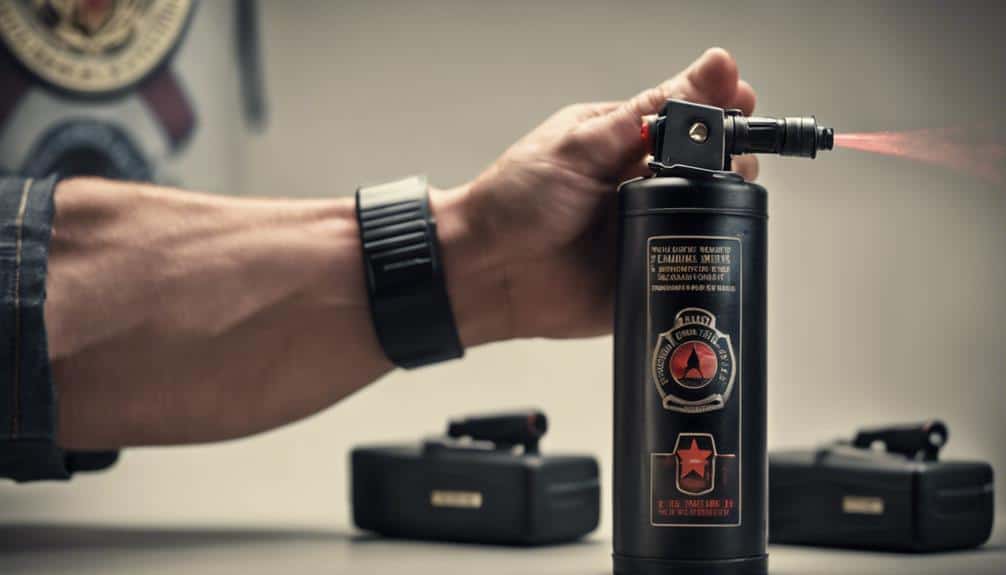Pepper spray and stun guns both offer effective
self-defense options, but each has unique perks to reflect on. Want to keep your distance? Pepper spray’s
25-foot reach helps you stay safer, whereas stun guns require closer contact but work rain or shine. Stun guns provide
instant incapacitation for up to a minute, giving you precious seconds to flee, while pepper spray’s effects last longer, up to an hour, ensuring your getaway.
User-friendliness? Pepper spray wins with easy deployment and minimal training, but let’s not forget the potential legal hurdles—both tools have their own regulations. Curious about which is best for your needs? Let’s explore!
Efficacy in Self-Defense
When it comes to
self-defense, understanding the efficacy of
pepper spray and
stun guns is essential for making the right choice. Both are effective tools for personal safety, but they work in different ways.
Pepper spray induces
temporary blindness and breathing difficulties, allowing you to
escape from multiple attackers, especially in crowded areas. Its wide dispersal range of up to 25 feet gives you a safe distance to react. However,
environmental factors like wind and rain can reduce its effectiveness, so it’s less reliable outdoors.
On the other hand,
stun guns, also known as Tasers, disrupt an attacker’s neuromuscular system, providing
immediate incapacitation for 30 seconds to 1 minute. This allows you to make a safe escape while the attacker is temporarily immobilized. Although Tasers have a shorter range of up to 15 feet compared to pepper spray, they’re not affected by environmental conditions, making them a more dependable choice in various settings.
Both options offer significant advantages. Pepper spray’s effects can last up to an hour, giving you plenty of time to get to safety, while stun guns offer immediate and reliable incapacitation. Ultimately, the best choice depends on your
personal safety needs and situational factors.
User-Friendliness
Considering user-friendliness, pepper spray stands out for its simple and quick deployment, making it ideal for individuals without prior training. Just press a nozzle, and you’re ready to go! Its compact size and lightweight nature mean you can easily carry it on a key ring or clip it to your purse, making it highly accessible. You don’t need to be a self-defense expert to use pepper spray effectively, which is a big plus.
On the other hand, stun guns require a bit more finesse. You need to aim correctly and understand how to operate the device, which can be challenging without proper training. Regular practice is essential to guarantee you can deploy it effectively in a real-life situation. While both tools are designed for ease of use, pepper spray wins the user-friendly contest, hands down.
| Feature |
Pepper Spray |
Stun Guns |
| Deployment |
Simple, press nozzle |
Requires aim |
| Training Needed |
Minimal |
Essential |
| Accessibility |
High, compact size |
Moderate, bulkier |
| Ease of Use |
Very user-friendly |
Requires practice |
Range and Distance
Regarding range and distance,
pepper spray offers a significant advantage with its
effective reach of up to
25 feet. This means you can maintain a safer distance from an assailant, giving you more room to react and escape if needed.
Imagine being in a crowded environment; the ability to keep an attacker at bay from a distance can provide a vital
tactical advantage in personal defense.
On the other hand, a
stun gun typically has an effective range of up to 15 feet, requiring closer proximity to incapacitate an attacker. While 15 feet isn’t shabby, it does mean you need to get a bit more up-close-and-personal, which isn’t always ideal when someone’s charging at you.
However,
environmental factors come into play with pepper spray. Wind can mess with your deployment accuracy, potentially blowing the spray back at you instead of your target.
A stun gun, meanwhile, remains effective regardless of
wind conditions, as long as you’re within its effective range.
Impact Duration
When it comes to
impact duration, pepper spray and stun guns offer different advantages and limitations.
Pepper spray can
incapacitate an attacker for up to an hour, giving you ample time to
escape.
In contrast, stun guns provide a shorter burst of incapacitation lasting from 10 seconds to a minute.
Imagine trying to dodge a movie villain with pepper spray—their eyes are burning, and they’re stumbling around for ages.
On the other hand, a stun gun gives you just enough time to make a
quick getaway like an action hero!
Duration of Effects
Pepper spray’s effects can last up to an hour, giving you a longer window to escape, while a
Taser’s incapacitation typically lasts under a minute. The duration of effects of these self-defense tools plays a significant role in determining their effectiveness.
With pepper spray, you can cause
temporary blindness and
severe irritation to your attacker, making it harder for them to continue their assault. This can be a lifesaver when you need more time to flee or call for help. However, there’s a catch: the attacker might recover and potentially re-engage after the effects wear off.
On the flip side, a Taser offers
immediate incapacitation by disrupting the attacker’s
neuromuscular control. This short-lived but intense effect can halt an assailant in their tracks, giving you precious seconds to escape. Yet, the incapacitation duration is brief, lasting around 30 seconds to a minute. Once the effect wears off, the attacker could regain their senses and continue their aggression.
In terms of
self-defense strategies, pepper spray is advantageous for longer engagements, while a Taser is more suited for
immediate threats. Choosing between them depends on your
specific needs and the situations you anticipate facing.
Escape Opportunity Timeframe
The duration of effects directly influences the escape opportunity timeframe, determining how much time you have to get to safety. When you’re in a sticky situation, every second counts.
With pepper spray, the effects can last up to an hour, giving you ample time to distance yourself from the attacker and seek help. In contrast, a Taser provides immediate immobilization but only lasts around 30 seconds to a minute, requiring quick action on your part to flee before the attacker regains mobility.
Understanding how these tools impact your escape opportunity can make a considerable difference in your self-defense strategy. Let’s break it down:
- Pepper spray: Offers longer-lasting effects, providing a broader window for escape.
- Taser: Immediate but short-term incapacitation, requiring fast action.
- Personal safety: Longer duration means more time to find safety or call for help.
Choosing between pepper spray and a Taser boils down to how much time you think you’ll need to get to safety. If you think you’ll need more time, pepper spray might be your best bet. Otherwise, a Taser could be your quick getaway tool.
Temporary Incapacitation Period
Have you ever wondered how long each
self-defense tool keeps an attacker
incapacitated? Well, when it comes to
pepper spray and stun guns, the incapacitation period can make all the difference in your
personal safety strategy.
Pepper spray can leave an assailant debilitated for up to
30 to 60 minutes, giving you a substantial window to escape or call for help. Imagine this: a cloud of fiery discomfort that lingers long enough for you to get far away from danger.
On the other hand, a
stun gun, while delivering a more intense and immediate shock, typically renders an attacker helpless for about
30 seconds to 1 minute. This might feel like forever in a tense situation, but it requires you to act quickly. You’ve got to be on your toes, ready to bolt the second the effects kick in.
The pepper spray’s longer incapacitation period can be a lifesaver in scenarios where you need to
create significant distance. Conversely, the stun gun’s shorter but powerful burst may not always provide ample time for a safe getaway if the attacker regains control swiftly.
Choosing the right tool depends heavily on your personal safety needs and your self-defense plan.
Legal Considerations
When it comes to
legal considerations, maneuvering the maze of
permit requirements and
usage restrictions is essential for both pepper spray and stun guns.
You’ll find that pepper spray is generally more accessible, but don’t get too comfortable—some states still have specific regulations that could trip you up.
On the other hand, stun guns often face stricter scrutiny, so be prepared to jump through a few more hoops if you want to carry one legally.
Permit Requirements
Before purchasing pepper spray or a stun gun, it’s crucial to understand local permit requirements and legal regulations. These self-defense tools can be lifesavers, but you need to navigate a maze of local laws to guarantee you’re compliant. Different states have varying rules, and what’s legal in one area might be a big no-no in another. For instance, while some places let you carry pepper spray without a hitch, others impose strict limitations on its size, strength, or formulation.
Here’s what you need to take into account:
- Permit requirements: Some states classify stun guns like firearms, meaning you might need a firearms permit to carry or use them.
- Local laws: Always check the specific regulations in your area regarding the possession of pepper spray and stun guns.
- Public spaces: Be aware that certain places might prohibit their use entirely, like schools or government buildings.
Usage Restrictions
Maneuvering the
usage restrictions for
pepper spray and
stun guns is vital to confirm you’re on the right side of the law.
Legal regulations differ wildly depending on your location, with some places requiring permits for even possessing these
self-defense options.
For instance, pepper spray might be limited by its size or strength, while stun guns could face outright bans in certain states. Imagine you’re carrying pepper spray for personal safety, only to find out that your local laws forbid the specific type you have. Or worse, you might deploy a stun gun in a situation deemed inappropriate by law, landing you with
criminal charges. Not fun, right? That’s why it’s important to explore the local laws governing these devices.
Compliance with legal regulations guarantees
responsible ownership, helping you avoid penalties or legal challenges after an incident. Misuse or overuse of either device can lead to serious repercussions, so understanding the nuances of usage restrictions is key.
Think of it as doing your homework to stay safe and legal. By familiarizing yourself with what’s allowed, you can confidently choose the best self-defense options without worrying about unintended
legal consequences.
Portability
Both pepper spray and stun guns are designed to be compact and easy to carry, making them practical choices for personal safety. Whether you’re jogging, commuting, or just running errands, these self-defense tools offer great portability.
Pepper spray is especially lightweight and often comes with key rings or clips, allowing you to attach it to your keys, purse, or belt for quick access. On the other hand, stun guns, while also compact, typically include holsters or wrist straps, making them easy to tuck into a purse or bag.
Let’s break down the portability features:
- Pepper spray can be deployed from a distance of up to 25 feet, giving you the advantage of maintaining space between you and an attacker.
- Stun guns require closer proximity, usually within 15 feet, which might limit their portability in certain situations.
- Both tools are designed for quick accessibility, ensuring you can react swiftly during potentially dangerous moments.
In terms of portability, the choice between pepper spray and a stun gun largely depends on your preferences for distance and accessibility. Both offer excellent options for enhancing your personal safety.
Training Requirements
Mastering the use of pepper spray or a stun gun requires
proper training to confirm effectiveness and safety.
With
pepper spray training, you’ll learn
aiming techniques to minimize the risk of
blowback, vital when the wind’s not on your side.
Regular practice sessions guarantee you can deploy it swiftly and accurately, even in the heat of the moment.
Taser training, on the other hand, involves understanding the correct aiming techniques and maintaining a
safe distance from your assailant. You won’t want to be too close when you pull the trigger! Proficiency with these self-defense tools isn’t just about hitting the target; it’s also about knowing when and how to use them within the bounds of
local laws.
Training programs often cover the legal use of these tools, so you’ll know your rights and responsibilities. It’s important to be aware of local laws to avoid any unintended legal trouble.
Thankfully, training resources are readily accessible, with numerous
self-defense workshops and courses available. These sessions not only boost your confidence but also guarantee you’re prepared for real-life situations.
Frequently Asked Questions
Which Is Better Pepper Spray or Stun Gun?
You should consider pepper spray for its self-defense effectiveness, range, and ease of use. However, a stun gun offers different advantages. Think about legal restrictions, training requirements, and personal safety to choose the best option for you.
What Are the Disadvantages of a Stun Gun?
You’ll face disadvantages with a stun gun: it requires close range, needs proper training for effectiveness, has legal restrictions, can be pricey, and demands maintenance. Alternatives like pepper spray offer broader coverage and ease of use.
Is Pepper Spray Actually Good for Self-Defense?
Pepper spray’s great for personal safety with an effectiveness range up to 25 feet. However, consider self-defense laws, health risks, and environmental factors. Proper usage techniques and training are essential due to potential legal and emotional impacts.
When picking the best self-defense weapon, consider self defense techniques, personal safety, and situational awareness. Self defense classes can boost confidence and debunk self defense myths. Evaluate legal considerations, effective strategies, and emergency preparedness for
women’s empowerment.









2 Responses